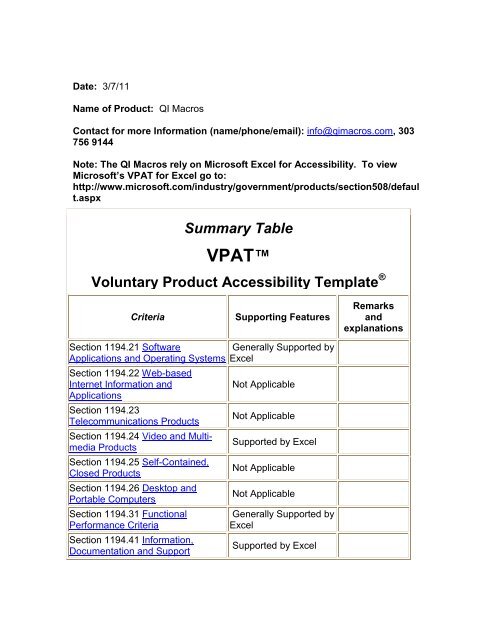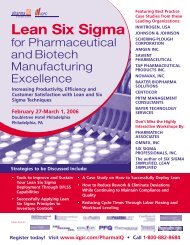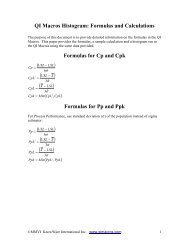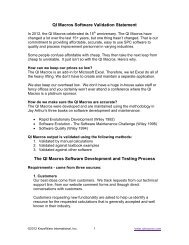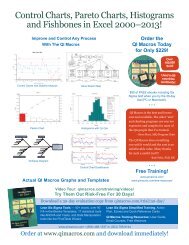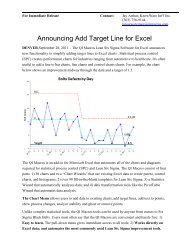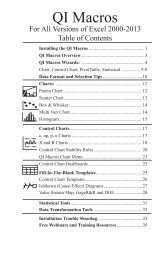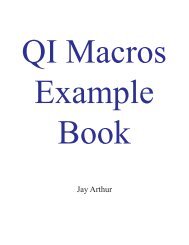ITI: Voluntary Product Accessibility Template - QI Macros for Excel
ITI: Voluntary Product Accessibility Template - QI Macros for Excel
ITI: Voluntary Product Accessibility Template - QI Macros for Excel
Create successful ePaper yourself
Turn your PDF publications into a flip-book with our unique Google optimized e-Paper software.
Date: 3/7/11<br />
Name of <strong>Product</strong>: <strong>QI</strong> <strong>Macros</strong><br />
Contact <strong>for</strong> more In<strong>for</strong>mation (name/phone/email): info@qimacros.com, 303<br />
756 9144<br />
Note: The <strong>QI</strong> <strong>Macros</strong> rely on Microsoft <strong>Excel</strong> <strong>for</strong> <strong>Accessibility</strong>. To view<br />
Microsoft’s VPAT <strong>for</strong> <strong>Excel</strong> go to:<br />
http://www.microsoft.com/industry/government/products/section508/defaul<br />
t.aspx<br />
Summary Table<br />
VPAT<br />
<strong>Voluntary</strong> <strong>Product</strong> <strong>Accessibility</strong> <strong>Template</strong> ®<br />
Criteria<br />
Supporting Features<br />
Remarks<br />
and<br />
explanations<br />
Section 1194.21 Software<br />
Applications and Operating Systems<br />
Section 1194.22 Web-based<br />
Internet In<strong>for</strong>mation and<br />
Applications<br />
Section 1194.23<br />
Telecommunications <strong>Product</strong>s<br />
Section 1194.24 Video and Multimedia<br />
<strong>Product</strong>s<br />
Section 1194.25 Self-Contained,<br />
Closed <strong>Product</strong>s<br />
Section 1194.26 Desktop and<br />
Portable Computers<br />
Section 1194.31 Functional<br />
Per<strong>for</strong>mance Criteria<br />
Section 1194.41 In<strong>for</strong>mation,<br />
Documentation and Support<br />
Generally Supported by<br />
<strong>Excel</strong><br />
Not Applicable<br />
Not Applicable<br />
Supported by <strong>Excel</strong><br />
Not Applicable<br />
Not Applicable<br />
Generally Supported by<br />
<strong>Excel</strong><br />
Supported by <strong>Excel</strong>
Return to the top of the page.<br />
Section 1194.21 Software Applications and<br />
Operating Systems – Detail<br />
VPAT<br />
<strong>Voluntary</strong> <strong>Product</strong> <strong>Accessibility</strong> <strong>Template</strong> ®<br />
Criteria<br />
Supporting Features<br />
Remarks<br />
and<br />
explanations<br />
Nudging (e.g.<br />
moving shapes in<br />
small amounts)<br />
can be difficult<br />
with the<br />
keyboard.<br />
(a) When software is designed to<br />
run on a system that has a<br />
keyboard, product functions shall be<br />
executable from a keyboard where<br />
the function itself or the result of<br />
per<strong>for</strong>ming a function can be<br />
discerned textually.<br />
Supported with Minor<br />
Exceptions by <strong>Excel</strong><br />
The context<br />
menu <strong>for</strong> sheet<br />
tabs cannot be<br />
accessed via the<br />
keyboard;<br />
however the<br />
same<br />
functionality <strong>for</strong><br />
switching tabs<br />
and sheets is<br />
located and<br />
accessible in<br />
other areas of the<br />
user interface.<br />
A user cannot<br />
directly access<br />
hyperlinks that<br />
utilize the<br />
=hyperlink<br />
function using<br />
the keyboard but<br />
can copy and
(b) Applications shall not disrupt or<br />
disable activated features of other<br />
products that are identified as<br />
accessibility features, where those<br />
features are developed and<br />
documented according to industry<br />
standards. Applications also shall<br />
not disrupt or disable activated<br />
features of any operating system<br />
that are identified as accessibility<br />
features where the application<br />
programming interface <strong>for</strong> those<br />
accessibility features has been<br />
documented by the manufacturer of<br />
the operating system and is<br />
available to the product developer.<br />
(c) A well-defined on-screen<br />
indication of the current focus shall<br />
be provided that moves among<br />
interactive interface elements as the<br />
input focus changes. The focus<br />
shall be programmatically exposed<br />
so that Assistive Technology can<br />
track focus and focus changes.<br />
(d) Sufficient in<strong>for</strong>mation about a<br />
user interface element including the<br />
identity, operation and state of the<br />
element shall be available to<br />
Assistive Technology. When an<br />
image represents a program<br />
element, the in<strong>for</strong>mation conveyed<br />
by the image must also be available<br />
in text.<br />
(e) When bitmap images are used<br />
to identify controls, status indicators,<br />
or other programmatic elements, the<br />
meaning assigned to those images<br />
shall be consistent throughout an<br />
application's per<strong>for</strong>mance.<br />
(f) Textual in<strong>for</strong>mation shall be<br />
provided through operating system<br />
functions <strong>for</strong> displaying text. The<br />
Supported by <strong>Excel</strong><br />
Supported by <strong>Excel</strong><br />
Supported by <strong>Excel</strong><br />
Supported by <strong>Excel</strong><br />
Supported by <strong>Excel</strong><br />
paste the URL<br />
into a browser.
minimum in<strong>for</strong>mation that shall be<br />
made available is text content, text<br />
input caret location, and text<br />
attributes.<br />
(g) Applications shall not override<br />
user selected contrast and color<br />
selections and other individual<br />
display attributes.<br />
(h) When animation is displayed,<br />
the in<strong>for</strong>mation shall be displayable<br />
in at least one non-animated<br />
presentation mode at the option of<br />
the user.<br />
(i) Color coding shall not be used as<br />
the only means of conveying<br />
in<strong>for</strong>mation, indicating an action,<br />
prompting a response, or<br />
distinguishing a visual element.<br />
(j) When a product permits a user to<br />
adjust color and contrast settings, a<br />
variety of color selections capable of<br />
producing a range of contrast levels<br />
shall be provided.<br />
(k) Software shall not use flashing<br />
or blinking text, objects, or other<br />
elements having a flash or blink<br />
frequency greater than 2 Hz and<br />
lower than 55 Hz.<br />
(l) When electronic <strong>for</strong>ms are used,<br />
the <strong>for</strong>m shall allow people using<br />
Assistive Technology to access the<br />
in<strong>for</strong>mation, field elements, and<br />
functionality required <strong>for</strong> completion<br />
and submission of the <strong>for</strong>m,<br />
including all directions and cues.<br />
Supported by <strong>Excel</strong><br />
Supported by <strong>Excel</strong><br />
Supported by <strong>Excel</strong><br />
Supported by <strong>Excel</strong><br />
Supported by <strong>Excel</strong><br />
Supported by <strong>Excel</strong><br />
Return to the top of the page.<br />
Section 1194.22 Web-based Internet<br />
in<strong>for</strong>mation and applications – Detail
VPAT<br />
<strong>Voluntary</strong> <strong>Product</strong> <strong>Accessibility</strong> <strong>Template</strong> ®<br />
Criteria<br />
(a) A text equivalent <strong>for</strong> every nontext<br />
element shall be provided (e.g.,<br />
via "alt", "longdesc", or in element<br />
content).<br />
(b) Equivalent alternatives <strong>for</strong> any<br />
multimedia presentation shall be<br />
synchronized with the presentation.<br />
(c) Web pages shall be designed so<br />
that all in<strong>for</strong>mation conveyed with<br />
color is also available without color,<br />
<strong>for</strong> example from context or markup.<br />
(d) Documents shall be organized<br />
so they are readable without<br />
requiring an associated style sheet.<br />
(e) Redundant text links shall be<br />
provided <strong>for</strong> each active region of a<br />
server-side image map.<br />
(f) Client-side image maps shall be<br />
provided instead of server-side<br />
image maps except where the<br />
regions cannot be defined with an<br />
available geometric shape.<br />
(g) Row and column headers shall<br />
be identified <strong>for</strong> data tables.<br />
(h) Markup shall be used to<br />
associate data cells and header<br />
cells <strong>for</strong> data tables that have two or<br />
more logical levels of row or column<br />
headers.<br />
(i) Frames shall be titled with text<br />
that facilitates frame identification<br />
and navigation<br />
(j) Pages shall be designed to avoid<br />
causing the screen to flicker with a<br />
Supporting Features<br />
Not Applicable<br />
Not Applicable<br />
Not Applicable<br />
Not Applicable<br />
Not Applicable<br />
Not Applicable<br />
Not Applicable<br />
Not Applicable<br />
Not Applicable<br />
Not Applicable<br />
Remarks<br />
and<br />
explanations
frequency greater than 2 Hz and<br />
lower than 55 Hz.<br />
(k) A text-only page, with equivalent<br />
in<strong>for</strong>mation or functionality, shall be<br />
provided to make a web site comply<br />
with the provisions of this part, when<br />
compliance cannot be accomplished<br />
in any other way. The content of the<br />
text-only page shall be updated<br />
whenever the primary page<br />
changes.<br />
(l) When pages utilize scripting<br />
languages to display content, or to<br />
create interface elements, the<br />
in<strong>for</strong>mation provided by the script<br />
shall be identified with functional<br />
text that can be read by Assistive<br />
Technology.<br />
(m) When a web page requires that<br />
an applet, plug-in or other<br />
application be present on the client<br />
system to interpret page content,<br />
the page must provide a link to a<br />
plug-in or applet that complies with<br />
§1194.21(a) through (l).<br />
(n) When electronic <strong>for</strong>ms are<br />
designed to be completed on-line,<br />
the <strong>for</strong>m shall allow people using<br />
Assistive Technology to access the<br />
in<strong>for</strong>mation, field elements, and<br />
functionality required <strong>for</strong> completion<br />
and submission of the <strong>for</strong>m,<br />
including all directions and cues.<br />
(o) A method shall be provided that<br />
permits users to skip repetitive<br />
navigation links.<br />
(p) When a timed response is<br />
required, the user shall be alerted<br />
and given sufficient time to indicate<br />
more time is required.<br />
Not Applicable<br />
Not Applicable<br />
Not Applicable<br />
Not Applicable<br />
Not Applicable<br />
Not Applicable<br />
Note to 1194.22: The Board interprets paragraphs (a) through (k) of this section<br />
as consistent with the following priority 1 Checkpoints of the Web Content<br />
<strong>Accessibility</strong> Guidelines 1.0 (WCAG 1.0) (May 5 1999) published by the Web
<strong>Accessibility</strong> Initiative of the World Wide Web Consortium: Paragraph (a) - 1.1,<br />
(b) - 1.4, (c) - 2.1, (d) - 6.1, (e) - 1.2, (f) - 9.1, (g) - 5.1, (h) - 5.2, (i) - 12.1, (j) - 7.1,<br />
(k) - 11.4.<br />
Return to the top of the page.<br />
Section 1194.23 Telecommunications <strong>Product</strong>s<br />
– Detail<br />
VPAT<br />
<strong>Voluntary</strong> <strong>Product</strong> <strong>Accessibility</strong> <strong>Template</strong> ®<br />
Criteria<br />
(a) Telecommunications products or<br />
systems which provide a function<br />
allowing voice communication and<br />
which do not themselves provide a<br />
TTY functionality shall provide a<br />
standard non-acoustic connection<br />
point <strong>for</strong> TTYs. Microphones shall<br />
be capable of being turned on and<br />
off to allow the user to intermix<br />
speech with TTY use.<br />
(b) Telecommunications products<br />
which include voice communication<br />
functionality shall support all<br />
commonly used cross-manufacturer<br />
non-proprietary standard TTY signal<br />
protocols.<br />
(c) Voice mail, auto-attendant, and<br />
interactive voice response<br />
telecommunications systems shall<br />
be usable by TTY users with their<br />
TTYs.<br />
(d) Voice mail, messaging, autoattendant,<br />
and interactive voice<br />
response telecommunications<br />
systems that require a response<br />
Supporting Features<br />
Not Applicable<br />
Not Applicable<br />
Not Applicable<br />
Not Applicable<br />
Remarks<br />
and<br />
explanations
from a user within a time interval,<br />
shall give an alert when the time<br />
interval is about to run out, and shall<br />
provide sufficient time <strong>for</strong> the user to<br />
indicate more time is required.<br />
(e) Where provided, caller<br />
identification and similar<br />
telecommunications functions shall<br />
also be available <strong>for</strong> users of TTYs,<br />
and <strong>for</strong> users who cannot see<br />
displays.<br />
(f) For transmitted voice signals,<br />
telecommunications products shall<br />
provide a gain adjustable up to a<br />
minimum of 20 dB. For incremental<br />
volume control, at least one<br />
intermediate step of 12 dB of gain<br />
shall be provided.<br />
(g) If the telecommunications<br />
product allows a user to adjust the<br />
receive volume, a function shall be<br />
provided to automatically reset the<br />
volume to the default level after<br />
every use.<br />
(h) Where a telecommunications<br />
product delivers output by an audio<br />
transducer which is normally held<br />
up to the ear, a means <strong>for</strong> effective<br />
magnetic wireless coupling to<br />
hearing technologies shall be<br />
provided.<br />
(i) Interference to hearing<br />
technologies (including hearing<br />
aids, cochlear implants, and<br />
assistive listening devices) shall be<br />
reduced to the lowest possible level<br />
that allows a user of hearing<br />
technologies to utilize the<br />
telecommunications product.<br />
(j) <strong>Product</strong>s that transmit or conduct<br />
in<strong>for</strong>mation or communication, shall<br />
pass through cross-manufacturer,<br />
non-proprietary, industry-standard<br />
codes, translation protocols, <strong>for</strong>mats<br />
Not Applicable<br />
Not Applicable<br />
Not Applicable<br />
Not Applicable<br />
Not Applicable<br />
Not Applicable
or other in<strong>for</strong>mation necessary to<br />
provide the in<strong>for</strong>mation or<br />
communication in a usable <strong>for</strong>mat.<br />
Technologies which use encoding,<br />
signal compression, <strong>for</strong>mat<br />
trans<strong>for</strong>mation, or similar techniques<br />
shall not remove in<strong>for</strong>mation<br />
needed <strong>for</strong> access or shall restore it<br />
upon delivery.<br />
(k)(1) <strong>Product</strong>s which have<br />
mechanically operated controls or<br />
keys shall comply with the following:<br />
Controls and Keys shall be tactilely<br />
discernible without activating the<br />
controls or keys.<br />
(k)(2) <strong>Product</strong>s which have<br />
mechanically operated controls or<br />
keys shall comply with the following:<br />
Controls and Keys shall be operable<br />
with one hand and shall not require<br />
tight grasping, pinching, twisting of<br />
the wrist. The <strong>for</strong>ce required to<br />
activate controls and keys shall be 5<br />
lbs. (22.2N) maximum.<br />
(k)(3) <strong>Product</strong>s which have<br />
mechanically operated controls or<br />
keys shall comply with the following:<br />
If key repeat is supported, the delay<br />
be<strong>for</strong>e repeat shall be adjustable to<br />
at least 2 seconds. Key repeat rate<br />
shall be adjustable to 2 seconds per<br />
character.<br />
(k)(4) <strong>Product</strong>s which have<br />
mechanically operated controls or<br />
keys shall comply with the following:<br />
The status of all locking or toggle<br />
controls or keys shall be visually<br />
discernible, and discernible either<br />
through touch or sound.<br />
Not Applicable<br />
Not Applicable<br />
Not Applicable<br />
Not Applicable<br />
Return to the top of the page.
Section 1194.24 Video and Multi-media<br />
<strong>Product</strong>s – Detail<br />
VPAT<br />
<strong>Voluntary</strong> <strong>Product</strong> <strong>Accessibility</strong> <strong>Template</strong> ®<br />
Criteria<br />
a) All analog television<br />
displays 13 inches and<br />
larger, and computer<br />
equipment that includes<br />
analog television receiver<br />
or display circuitry, shall<br />
be equipped with caption<br />
decoder circuitry which<br />
appropriately receives,<br />
decodes, and displays<br />
closed captions from<br />
broadcast, cable,<br />
videotape, and DVD<br />
signals. As soon as<br />
practicable, but not later<br />
than July 1, 2002,<br />
widescreen digital<br />
television (DTV) displays<br />
measuring at least 7.8<br />
inches vertically, DTV<br />
sets with conventional<br />
displays measuring at<br />
least 13 inches vertically,<br />
and stand-alone DTV<br />
tuners, whether or not<br />
they are marketed with<br />
display screens, and<br />
computer equipment that<br />
includes DTV receiver or<br />
display circuitry, shall be<br />
equipped with caption<br />
decoder circuitry which<br />
appropriately receives,<br />
Supporting Features<br />
Not Applicable<br />
Remarks and<br />
explanations
decodes, and displays<br />
closed captions from<br />
broadcast, cable,<br />
videotape, and DVD<br />
signals.<br />
(b) Television tuners,<br />
including tuner cards <strong>for</strong><br />
use in computers, shall<br />
be equipped with<br />
secondary audio program<br />
playback circuitry.<br />
(c) All training and<br />
in<strong>for</strong>mational video and<br />
multimedia productions<br />
which support the<br />
agency's mission,<br />
regardless of <strong>for</strong>mat, that<br />
contain speech or other<br />
audio in<strong>for</strong>mation<br />
necessary <strong>for</strong> the<br />
comprehension of the<br />
content, shall be open or<br />
closed captioned.<br />
(d) All training and<br />
in<strong>for</strong>mational video and<br />
multimedia productions<br />
which support the<br />
agency's mission,<br />
regardless of <strong>for</strong>mat, that<br />
contain visual in<strong>for</strong>mation<br />
necessary <strong>for</strong> the<br />
comprehension of the<br />
content, shall be audio<br />
described.<br />
(e) Display or<br />
presentation of alternate<br />
text presentation or audio<br />
descriptions shall be<br />
user-selectable unless<br />
permanent.<br />
Return to the top of the page.<br />
Not Applicable<br />
Supported by <strong>Excel</strong><br />
Supported by <strong>Excel</strong><br />
Supported by <strong>Excel</strong>
Section 1194.25 Self-Contained, Closed<br />
<strong>Product</strong>s – Detail<br />
VPAT<br />
<strong>Voluntary</strong> <strong>Product</strong> <strong>Accessibility</strong> <strong>Template</strong> ®<br />
Criteria<br />
(a) Self contained<br />
products shall be usable<br />
by people with disabilities<br />
without requiring an enduser<br />
to attach Assistive<br />
Technology to the<br />
product. Personal<br />
headsets <strong>for</strong> private<br />
listening are not Assistive<br />
Technology.<br />
(b) When a timed<br />
response is required, the<br />
user shall be alerted and<br />
given sufficient time to<br />
indicate more time is<br />
required.<br />
(c) Where a product<br />
utilizes touchscreens or<br />
contact-sensitive<br />
controls, an input method<br />
shall be provided that<br />
complies with §1194.23<br />
(k) (1) through (4).<br />
(d) When biometric <strong>for</strong>ms<br />
of user identification or<br />
control are used, an<br />
alternative <strong>for</strong>m of<br />
identification or<br />
activation, which does<br />
not require the user to<br />
possess particular<br />
biological characteristics,<br />
shall also be provided.<br />
Supporting Features<br />
Not Applicable<br />
Not Applicable<br />
Not Applicable<br />
Not Applicable<br />
Remarks and<br />
explanations
(e) When products<br />
provide auditory output,<br />
the audio signal shall be<br />
provided at a standard<br />
signal level through an<br />
industry standard<br />
connector that will allow<br />
<strong>for</strong> private listening. The<br />
product must provide the<br />
ability to interrupt, pause,<br />
and restart the audio at<br />
anytime.<br />
(f) When products deliver<br />
voice output in a public<br />
area, incremental volume<br />
control shall be provided<br />
with output amplification<br />
up to a level of at least<br />
65 dB. Where the<br />
ambient noise level of the<br />
environment is above 45<br />
dB, a volume gain of at<br />
least 20 dB above the<br />
ambient level shall be<br />
user selectable. A<br />
function shall be provided<br />
to automatically reset the<br />
volume to the default<br />
level after every use.<br />
(g) Color coding shall not<br />
be used as the only<br />
means of conveying<br />
in<strong>for</strong>mation, indicating an<br />
action, prompting a<br />
response, or<br />
distinguishing a visual<br />
element.<br />
(h) When a product<br />
permits a user to adjust<br />
color and contrast<br />
settings, a range of color<br />
selections capable of<br />
producing a variety of<br />
contrast levels shall be<br />
provided.<br />
Not Applicable<br />
Not Applicable<br />
Not Applicable<br />
Not Applicable
(i) <strong>Product</strong>s shall be<br />
designed to avoid<br />
causing the screen to<br />
flicker with a frequency<br />
greater than 2 Hz and<br />
lower than 55 Hz.<br />
(j) (1) <strong>Product</strong>s which are<br />
freestanding, nonportable,<br />
and intended to<br />
be used in one location<br />
and which have operable<br />
controls shall comply with<br />
the following: The<br />
position of any operable<br />
control shall be<br />
determined with respect<br />
to a vertical plane, which<br />
is 48 inches in length,<br />
centered on the operable<br />
control, and at the<br />
maximum protrusion of<br />
the product within the 48<br />
inch length on products<br />
which are freestanding,<br />
non-portable, and<br />
intended to be used in<br />
one location and which<br />
have operable controls.<br />
(j)(2) <strong>Product</strong>s which are<br />
freestanding, nonportable,<br />
and intended to<br />
be used in one location<br />
and which have operable<br />
controls shall comply with<br />
the following: Where any<br />
operable control is 10<br />
inches or less behind the<br />
reference plane, the<br />
height shall be 54 inches<br />
maximum and 15 inches<br />
minimum above the floor.<br />
(j)(3) <strong>Product</strong>s which are<br />
freestanding, nonportable,<br />
and intended to<br />
be used in one location<br />
Not Applicable<br />
Not Applicable<br />
Not Applicable<br />
Not Applicable
and which have operable<br />
controls shall comply with<br />
the following: Where any<br />
operable control is more<br />
than 10 inches and not<br />
more than 24 inches<br />
behind the reference<br />
plane, the height shall be<br />
46 inches maximum and<br />
15 inches minimum<br />
above the floor.<br />
(j)(4) <strong>Product</strong>s which are<br />
freestanding, nonportable,<br />
and intended to<br />
be used in one location<br />
and which have operable<br />
controls shall comply with<br />
the following: Operable<br />
controls shall not be<br />
more than 24 inches<br />
behind the reference<br />
plane.<br />
Not Applicable<br />
Return to the top of the page.<br />
Section 1194.26 Desktop and Portable<br />
Computers – Detail<br />
VPAT<br />
<strong>Voluntary</strong> <strong>Product</strong> <strong>Accessibility</strong> <strong>Template</strong> ®<br />
Criteria<br />
(a) All mechanically<br />
operated controls and<br />
keys shall comply with<br />
§1194.23 (k) (1) through<br />
(4).<br />
(b) If a product utilizes<br />
touchscreens or touch-<br />
Supporting Features<br />
Not Applicable<br />
Not Applicable<br />
Remarks and<br />
explanations
operated controls, an<br />
input method shall be<br />
provided that complies<br />
with §1194.23 (k) (1)<br />
through (4).<br />
(c) When biometric <strong>for</strong>ms<br />
of user identification or<br />
control are used, an<br />
alternative <strong>for</strong>m of<br />
identification or<br />
activation, which does<br />
not require the user to<br />
possess particular<br />
biological characteristics,<br />
shall also be provided.<br />
(d) Where provided, at<br />
least one of each type of<br />
expansion slots, ports<br />
and connectors shall<br />
comply with publicly<br />
available industry<br />
standards<br />
Not Applicable<br />
Not Applicable<br />
Return to the top of the page.<br />
Section 1194.31 Functional Per<strong>for</strong>mance<br />
Criteria – Detail<br />
VPAT<br />
<strong>Voluntary</strong> <strong>Product</strong> <strong>Accessibility</strong> <strong>Template</strong> ®<br />
Criteria<br />
Supporting Features<br />
Remarks and<br />
explanations<br />
(a) At least one mode of<br />
operation and in<strong>for</strong>mation<br />
retrieval that does not<br />
require user vision shall<br />
be provided, or support<br />
<strong>for</strong> Assistive Technology<br />
used by people who are<br />
Supported with Minor<br />
Exceptions by <strong>Excel</strong>
lind or visually impaired<br />
shall be provided.<br />
(b) At least one mode of<br />
operation and in<strong>for</strong>mation<br />
retrieval that does not<br />
require visual acuity<br />
greater than 20/70 shall<br />
be provided in audio and<br />
enlarged print output<br />
working together or<br />
independently, or support<br />
<strong>for</strong> Assistive Technology<br />
used by people who are<br />
visually impaired shall be<br />
provided.<br />
(c) At least one mode of<br />
operation and in<strong>for</strong>mation<br />
retrieval that does not<br />
require user hearing shall<br />
be provided, or support<br />
<strong>for</strong> Assistive Technology<br />
used by people who are<br />
deaf or hard of hearing<br />
shall be provided<br />
(d) Where audio<br />
in<strong>for</strong>mation is important<br />
<strong>for</strong> the use of a product,<br />
at least one mode of<br />
operation and in<strong>for</strong>mation<br />
retrieval shall be<br />
provided in an enhanced<br />
auditory fashion, or<br />
support <strong>for</strong> assistive<br />
hearing devices shall be<br />
provided.<br />
(e) At least one mode of<br />
operation and in<strong>for</strong>mation<br />
retrieval that does not<br />
require user speech shall<br />
be provided, or support<br />
<strong>for</strong> Assistive Technology<br />
used by people with<br />
disabilities shall be<br />
provided.<br />
Supported by <strong>Excel</strong><br />
Not Applicable<br />
Not Applicable<br />
Supported by <strong>Excel</strong>
(f) At least one mode of<br />
operation and in<strong>for</strong>mation<br />
retrieval that does not<br />
require fine motor control<br />
or simultaneous actions<br />
and that is operable with<br />
limited reach and<br />
strength shall be<br />
provided.<br />
Return to the top of the page.<br />
Supported with Minor<br />
Exceptions by <strong>Excel</strong><br />
Section 1194.41 In<strong>for</strong>mation, Documentation<br />
and Support – Detail<br />
VPAT<br />
<strong>Voluntary</strong> <strong>Product</strong> <strong>Accessibility</strong> <strong>Template</strong> ®<br />
Criteria<br />
Supporting Features<br />
Remarks and<br />
explanations<br />
(a) <strong>Product</strong> support<br />
documentation provided<br />
to end-users shall be<br />
made available in<br />
alternate <strong>for</strong>mats upon<br />
request, at no additional<br />
charge<br />
(b) End-users shall have<br />
access to a description of<br />
the accessibility and<br />
compatibility features of<br />
products in alternate<br />
<strong>for</strong>mats or alternate<br />
methods upon request, at<br />
no additional charge.<br />
(c) Support services <strong>for</strong><br />
products shall<br />
accommodate the<br />
communication needs of<br />
end-users with<br />
Supported by <strong>Excel</strong><br />
Supported by <strong>Excel</strong><br />
Supported by <strong>Excel</strong>
disabilities.<br />
Return to the top of the page.


